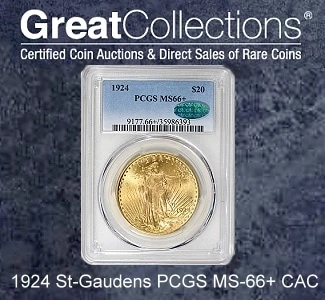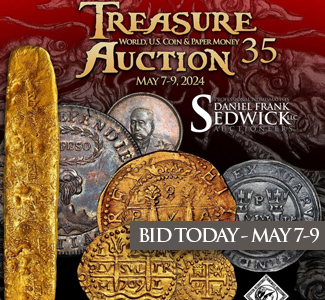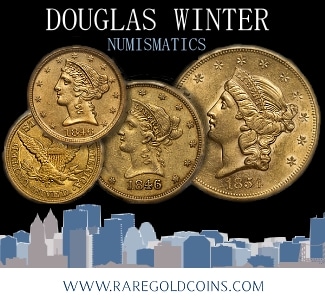By Steve Benner for CoinWeek …..
This is the second article in a series on the Greek colonies on the northern coast of the Black Sea (Euxine Sea). The first article was on Olbia, and this one covers the cities of Tyras and Chersonesus.
Most of the colonies in the area, which is now southern Ukraine and Russia, were settled in the seventh through fifth centuries BCE by the city of Miletus, though Heraclea Pontica established Chersonesus. The soil in this region is very rich, referred to as the “Black Land”, and cities’ economies were based on agriculture, fishing, viticulture, manufacturing, and slaves. The settlements were also known for their stonecutting, construction, metalworking, pottery, and jewelry, and traded not only with the Greek cities of Asia Minor and Greece proper but also with local tribes like the Scythians, the Sindians, the Sarmatians, the Taurians, and the Maeotians. Wine, weapons, sculptures, vases, slaves, and precious textiles passed through their hands, and, as a result, the cities became very wealthy.
In the second century, the local tribes began to raid the colonies, and they went into decline. The Bosporan Kingdom, established in 480 as a confederation of cities, provided some help, but it wasn’t until Mithridates VI of Pontus incorporated the region into his empire at the start of the first century CE that the tribes were driven back. Mithridates died in 63, and eventually, all the cities came under the domination of Rome.
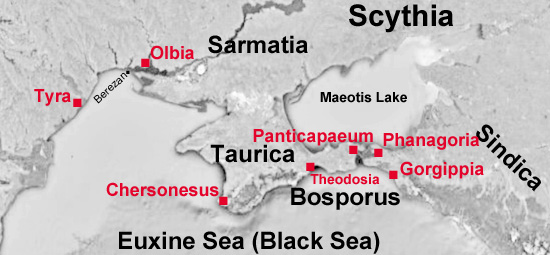
Tyras or Tyra
Tyras (now Bilhorod-Dnistrovskyi) was founded by Miletus in about 600 and was located on the right bank of the Tyras River (Dniester River) estuary. The native tribe in the area was called the Tyrasgetae.
The city-state prospered and was a major trading center by the fourth century, dealing in wheat, wine, and fish. It traded with tribes of the interior and with Greek cities as far away as Athens. Tyras’ government was similar to other Greek city-states at the time, being ruled by five archons with a senate, a popular assembly, and a registrar. Its public buildings included a council chamber and a temple to Apollo Intros.
Around 340 BCE, Tyras fell under the rule of the Scythian king Ataias, and after his death the city came under the dominion of the Macedonian Lysimachos. By the end of the third century, it was again under the control of Scythian kings, whose names appear on some of Tyras’ coins. Mithridates VI drove the Scythians out by the end of the second century. Then in the 50s BCE, the Thracian Getae destroyed Tyras but the Romans soon rebuilt the city, which then became part of the province of Lower Moesia.
Tyras began minting coins early in the fourth century–mostly bronzes, with a few silver and gold coins–and stopped by the end of the second. The variety of types minted by the city was not very extensive, especially compared to coinage from mainland Greece. The piece shown in Figure 2 is one of those few silver coins minted in the mid-fourth century to the Aiginetic standard. The obverse has the head of Demeter, which is a reference to the grain grown and exported in the area, and the reverse has a bull butting left, which probably represents the Tyras River. The city ethic TYPANO is above the bull.
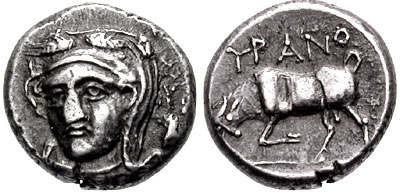
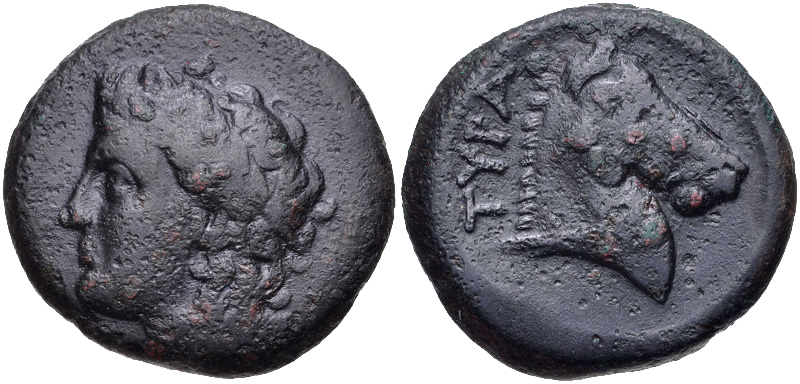
The third coin is an example of the only gold coins that Tyras minted during its existence. This Attic-standard stater, shown in Figure 4, was minted at the beginning of the second century. It is done in the style of the Byzantian coins issued by Lysimachos in the previous century. These gold coins were probably minted to use as tribute to the Scythians and other local tribes.
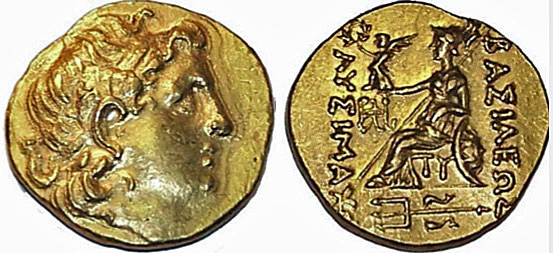
The silver and gold coins of Tyras can be very expensive due to their scarcity (see Figures 2 & 4), but the bronze coins tend to be sold at more reasonable prices (see Figure 3).
Chersonesus
Chersonesus, today near Sevastopol, was settled in 422-1 by Megaran colonists from Heraclea Pontica in Bithynia at the southwest corner of the Tauric (Crimean) peninsula. The word chersonesus means “peninsula”, and the city was founded on a peninsula between two bays (“Tauric Chersonesus” refers to the whole of the southern Tauric peninsula).
The Taurians were the local tribes who were there when the colony was established. The city flourished from the fourth into the first century BCE; its economy was based on viticulture, fishing, and manufacturing, as well as trade in grain, cattle, and fish with the rest of the Greek world and with local tribes. As with most colonies, the city depended upon the surrounding agricultural territory, called the chora.
The location of Chersonesus was also ideal for trading with the other colonies along the coast, and it established its own colony at Karkinitis on the northwest coast of the Tauric peninsula.
Early on, Chersonesus had a democratic form of government with elected Archons and a council called a Demiurgoi, but with time the government became more oligarchic, concentrating power within the hands of the Archons. The city had a temple to Artemis, a theater, and defensive walls. Excavated burials indicate that the city absorbed much of the native population.
In the third century as with Tyras, the Scythians started raiding the city, and Chersonesus appealed to the Bosporan Kingdom for help. This Kingdom was a confederation of cities in the eastern Tauric peninsula and, just across the Strait of Kerch, the Taman peninsula. It was established in 480 and had its capital at Panticapaeum.
The Kingdom temporarily relieved the pressure from the tribes but in the second century, Cherosensus had to ask Pharnakes I of Pontus for help. Pharnakes successfully drove off the raiding local tribes. This relationship continued on into the first century when Mithridates VI took over from his father as king of Pontus and head of the Bosporan Kingdom. Mithridates incorporated the whole area into his empire.
After Mithridates was defeated by the Romans and died in 63 CE, the city became part of the Kingdom of the Bosporus and later Rome. In 47, Julius Caesar proclaimed that Chersonesus was a civitas libera (“free city”).
Chersonesus began minting bronze and silver coins in the fourth century. Its issue of coins was robust because of its success as a commercial center. It produced numerous types, depicting a variety of gods and mythology, though Artemis appears most frequently. Figure 5 shows one of these early coins. It has Artemis on the obverse and a tunny fish and club on the reverse. XEP stands for the city name, CHER. Artemis was the Greek goddess of the hunt, the wilderness, wild animals, the moon, and sexual chastity, and a few of her epithets were Parthenos (“virgin”), Tauropolis (“hunting bull goddess”), Agrotera (“goddess of hunters”), and Elaphebolos (“stag slayer”).
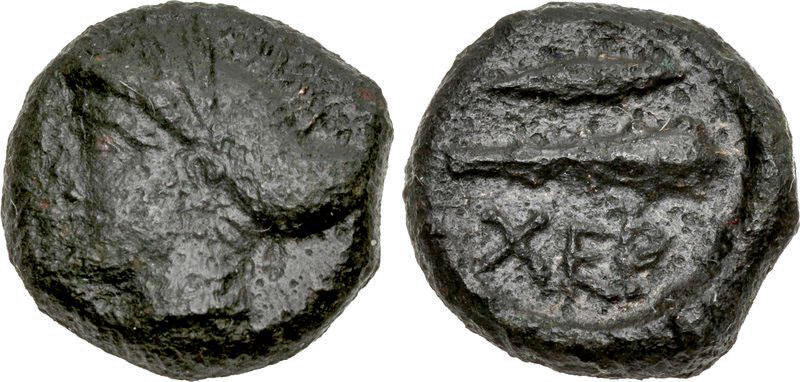
Many of the coins during the first decades of fourth century were very small, seven to 15 mm in diameter, though there are a few in the 20 mm range. Some of the other motifs depicted on the coins were a lion’s head, the scalp of a lion, a star, a boukranion (garlanded head of a ox), a bull, and a dolphin. The silver coins were minted on the Rhodian standard and were tetrobols, diobols, and obols – ususally with the obverse head of Artemis and reverse with a fish and club.
By mid-century, the artistry of the coins improved dramatically and their size increased and stayed around 20 mm. Figure 6 shows a coin of this type with a quadriga (four-horse chariot) on the obverse and a hoplite soldier on the reverse. As can be seen by comparison with the coin in Figure 5, the skill and design is much better on this coin.
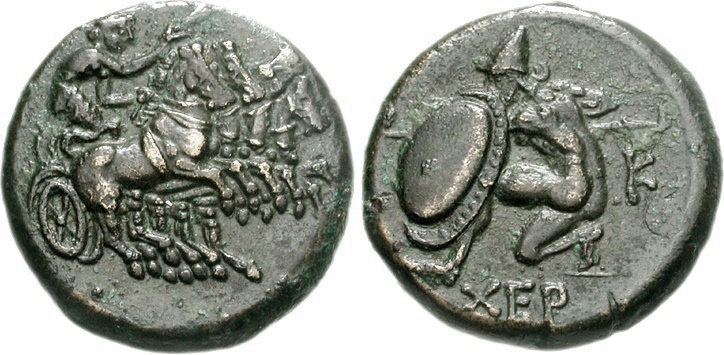
Two other similar bronze coins of this period have 1) Artemis on the obverse and a griffin on the reverse (SNG BM Black Sea 751), and 2) a janiform (two-faced) head with female and male faces on the obverse and a lion on top of a bull, biting its neck, on the reverse (SNG BM Black Sea 745).
Another attractive bronze coin that has come to epitomize Chersonesus coinage was minted between 300-290 BCE and is shown in Figure 7. It has Artemis about to pierce a stag with a spear on the obverse and a bull butting left on the reverse. Artemis was known as the stag slayer, and, as the moon goddess, her symbol was the bull. The name Klemutada is probably that of a magistrate or local ruler.
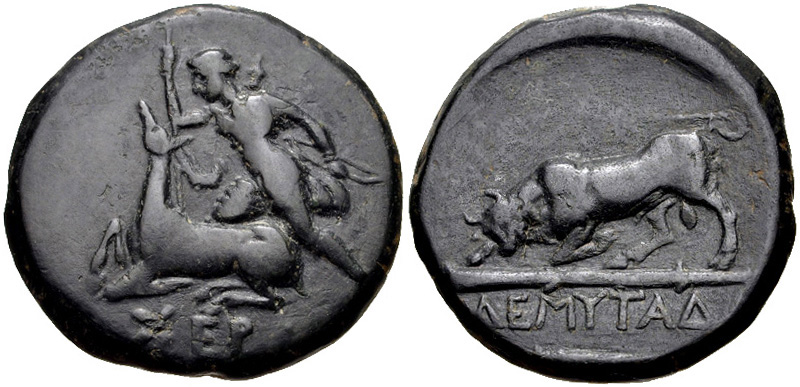
The minting of silver coins seemed to stop in the later part of the fourth century and started up again in the third. The silver coins were now larger (tetradrachms, etc.) on the Rhodian Standard. One of these is shown in Figure 8 and was minted between 250 and 230. The head of Herakles is on the obverse and probably refers to the demi-god’s visit to Scythia during one of his labors. There is a countermark of a lightning bolt on the obverse. The reverse is again a bull butting left. The name Xenonos most likely refers to a magistrate.
Figure 9 shows a drachm with an Artemis profile obverse and a reverse with Artemis about to spear a recumbent stag. A sliver hemidrachm (SNG BM Black Sea 784) of 2.59 grams(g) was also minted that has Artemis on the obverse and a butting bull on the reverse.
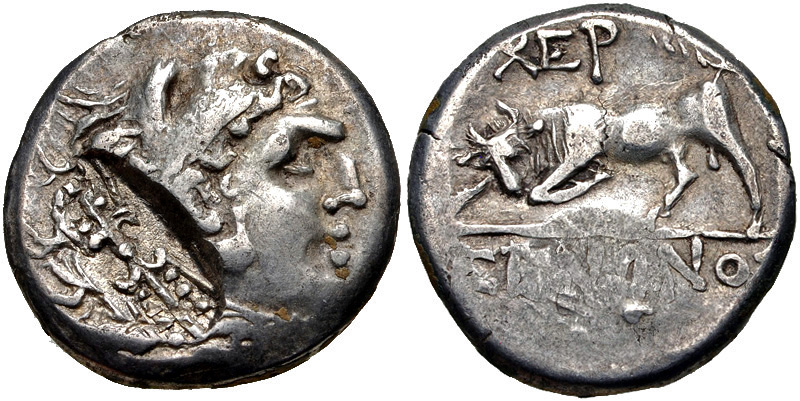
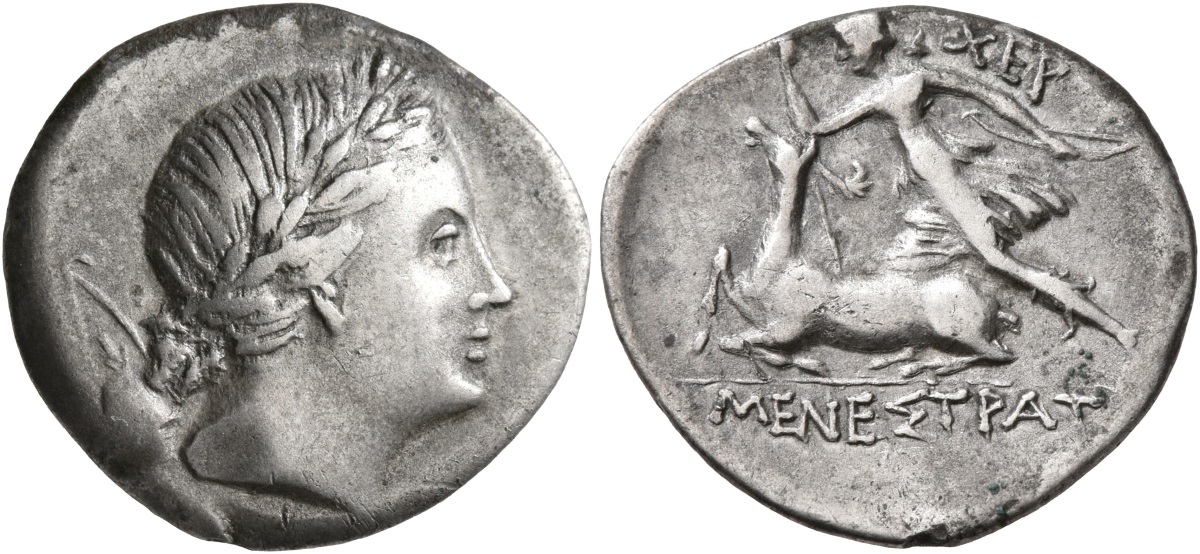
During the second century, Chersonesus minted tetradrachms on the Attic standard with the head of Alexander the Great obverse and a reverse with Athena enthroned. But the fortunes of the city began to wane due to raids by the Scythians. During the second century and into the first, Chersonesus was still minting coins, many of which were the small bronzes seen in its early years. Most of the coins have Artemis and a bull or stag. Figure 10 shows one that is a little more unusual in that it has head of one of the Discokouros wearing a conical helmet on the obverse and has the prow of a ship pointing left on the reverse. The city’s ethnic is above, and a magistrate’s name, Simaios, below.
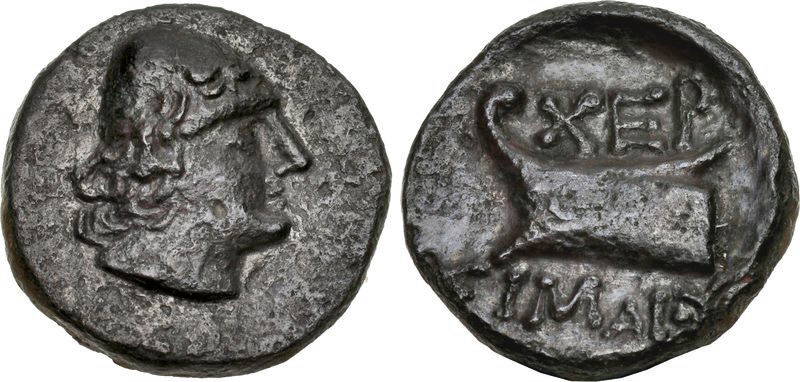
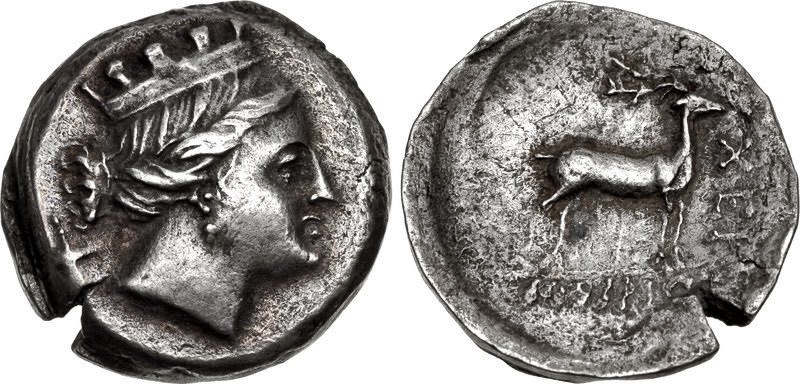
As with the coinage of other cities on the northern coast of the Black Sea (like Tyras), the silver coins of Chersonesus can be very expensive due to their scarcity (see Figure 11). In addition, some of the bronzes in Very Fine or better condition can also be pricey (see Figure 6). But, generally, the small bronzes can be obtained at reasonable prices (see Figures 5, 7, & 10).
* * *
References
Anokhin, V.A. Coins of antique cities of the North-Western Black Sea region. Kyiv (2011).
Cambridge Ancient History, VIII. Rome and the Mediterranean, 218-133 B.C.. Cambridge at University Press (1970).
Grant, Michael. A Guide to the Ancient World: A Dictionary of Classical Place Names. Barnes and Noble (1986).
Head, Barclay V. Historia Numorum: A Manual of Greek Numismatics. Oxford (1887).
Hoover, Oliver D. Handbook of Coins of Macedon and Its Neighbors. Part II: Thrace, Skythia, and Taurike, Sixth to First Centuries BC [The Handbook of Greek Coinage Series, Volume 3]. Classical Numismatic Group, LLC (2017).
Hornblower, Simon, and Antony Spawforth, editors. The Oxford Classical Dictionary. Oxford University Press (1996).
Petac, Emanuel. About the Chronology of the Posthumous Lysimachus Type Staters from Western and Northern Black Sea Region. XIV International Economic History Congress, Helsinki (2006).
Sear, David. Greek Coins and Their Values, Vol 2: Asia. B.A. Seaby Ltd. (1979).
* * *


